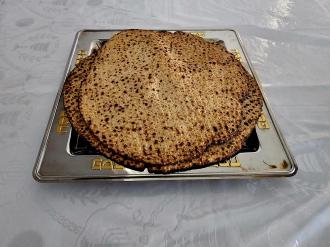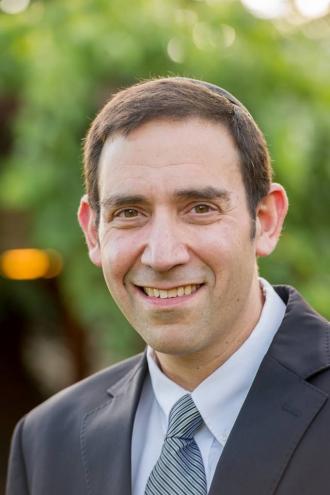Prior to Shavuos in previous years, I published articles on the topics of producing and eating dairy bread, how to make kosher cheese, whether Shavuos is preceded by Parshas Bamidbar or Parshas Naso, and about the laws of making pareve foods. All of these articles can be accessed on RabbiKaganoff.com
This year, I decided to distribute an article by my close friend, Rabbi Avraham Rosenthal, on the Ashkenazic custom of reciting Akdamus on Shavuos.
A common minhag among Ashkenazim is to read the beautiful poem of Akdamus at the beginning of the kerias haTorah on Shavuos morning. This article provides some basic historical and halachic background to this magnificent work.
The Author
The name of the person who composed Akdamus can be found as an acronymic in the lines of the poem. The first forty-four lines begin with the twenty-two letters of the aleph-bais, two lines per letter. The opening letters of the remaining forty-six lines of the poem spell out: “Meir bar Rebbi Yitzchok, yigadel baTorah ubemaasim tovim, amein, chazak ve’ematz” – “May Meir, the son of Rebbi Yitzchok, grow in Torah and good deeds, amein, be strong and fortified.”
Rebbi Meir ben Yitzchok, one of the early Rishonim, is mentioned by both Rashi and Tosafos (see Rashi, Tehillim 73:12 and Hoshei’a 6:9; see Tosafos, Rosh Hashanah 11a, s.v. ela). Rebbi Meir lived in the city of Vermeisa (Worms), the same city where Rashi lived when he traveled to Germany to study in yeshiva. The Shibbolei Haleket (#290) cites a responsum of Rashi, who writes, “I heard from the mouth of that tzaddik, Rebbi Meir bar Yitzchok...” No doubt upon this basis, the Sefer Hatodaah cites that Rashi, when a young man, studied Torah under Rebbi Meir bar Yitzchok.
Both Rashi and Tosafos refer to Rebbi Meir bar Yitzchok with the appellation “shaliach tzibbur.” It is recorded that he created a kiddush Hashem by valiantly defending Yiddishkeit in a forced debate with clergymen of the church, and it is also reported that the son of Rebbi Meir ben Yitzchok was killed al kiddush Hashem during the crusades in 4856 (1096), which occurred in Rashi’s lifetime.
Earliest Sources
The earliest extant sources of the custom to recite Akdamus on Shavuos morning appear in the fourteenth-century works, Sefer Haminhagim and Minhagei Maharil. These two collections of minhagim compile the vast majority of the customs of Ashkenazic Jewry.
Although neither the Shulchan Aruch nor the Rema mentions the custom, numerous Acharonim, such as the Levush, Taz, Elyah Rabbah and others, do cite it.
The Poem’s Structure
There are several other interesting facts concerning the structure of Akdamus:
1) Each line contains ten syllables. (Sheva and chataf sounds are not reckoned when counting syllables.) These ten syllables apparently represent the Aseres Hadibros which are read on Shavuos and in whose honor the poem was written (Moadei Kodesh [Rav Binyamin Adler] page 277).
2) Each line concludes with the letters tav-aleph. This alludes to the fact that the Torah has no end and no beginning. As soon as one “finishes,” symbolized by the letter “tav,” he goes back to the “aleph,” or the beginning (ibid.).
Why Aramaic?
3) Akdamus was composed in Aramaic, and the question has been raised why the composer chose this language. One possible reason is similar to the comments of Tosafos (Brachos 3a, s.v. ve’onin) concerning the fact that the Kaddish is written in Aramaic. Tosafos write, “Since this tefillah is so beautiful and it is a great praise, it was composed in the language of the targum (Aramaic) so that the angels will not understand it and be jealous of us.” Similarly, it can be said that the poem of Akdamus is so exceedingly beautiful that the author did not want to arouse the jealousy of the angels.
This reason is especially befitting when one takes into account the discussion cited in the Gemara (Shabbos 98b-99a) that took place prior to Matan Torah. The Gemara relates that when Moshe ascended to Heaven to receive the Torah, the angels were upset, complaining to Hashem that He intended to give His precious Torah to mere humans. Hashem instructed Moshe to respond. Moshe answered them that we can see from the various mitzvos of the Torah that the Torah is relevant only to human beings, and not to angels.
Since the angels had such a strong desire to keep the Torah for themselves, it would not be appropriate to read Akdamus, which speaks about the giving of the Torah to Klal Yisrael, in a language understandable to the angels (see Moadim Lesimchah, volume VI, page 466, footnote #6).
Fear of the Non-Jews
Another reason that has been suggested as to why Akdamus was composed in Aramaic is due to the fear of retribution by the non-Jews. One of the themes mentioned in Akdamus is the praise of Klal Yisrael, as well as the denigration of non-Jews (ibid, page 469).
Worms Exception
As an interesting aside, one of the Ashkenazic European communities that did not follow the practice of reciting Akdamus is none other than the composer’s home town of Vermeisa, Worms. According to a comment in the sefer minhagim of the Vermeisa community, the traditional reason why they do not recite this poem is because one year, a chazzan gave a particularly beautiful rendition of Akdamus with an exceptional level of intensity, and upon completing it, the chazzan suddenly passed away. Due to this, the community discontinued reciting it.
However, the author of this comment takes issue with this reason and maintains that such a reason is insufficient. Akdamus is such a lofty poem it should be recited every year. Rather, the commentator suggests that the Vermeisa community did not recite Akdamus out of fear, because the local anti-Semites were once defeated in a debate by the poem’s composer (see Moadim Lesimcha, page 469, footnote #7).
Permission to the Translator
In order to understand the next suggestion as to why Akdamus was composed in Aramaic, an introduction is required. During the time of Chazal, it was customary that, during kerias haTorah, a person would read the Aramaic translation of the pesukim, the Targum, which was the spoken language at the time. This was to ensure that the participants would understand what was being read. During the time of the Rishonim, this practice began to fall into disuse and the Targum was read only on special occasions, such as during the Yomim Tovim. Additionally, it became the practice to begin the Aramaic translation of the parsha being read with a “reshus” – an introduction of sorts in which the translator asks for “permission” to begin the translation. This “reshus” was also recited in Aramaic.
This idea of beginning with a “reshus” is similar to the practice of the shaliach tzibbur asking “permission” to interrupt the davening with the piyutim. Since most congregations today recite piyutim only on the Yomim Nora’im, the reshus is usually recited only on those days.
It has been suggested that Akdamus was composed as a reshus for the translator prior to beginning his translation of the Aseres Hadibros. Since the spoken language was Aramaic, it was logical that the reshus should be in that language (Rav Wolf Heidenheim, Chumash Me’iras Ainayim, cited in Moadim Lesimcha, page 470).
The Great Controversy
A great halachic debate arose concerning when we recite the poem of Akdamus. The early sources that cite the minhag, such as the Maharil and the Sefer Minhagim, write that Akdamus is recited after the baal kriyah has read the first pasuk of the leining. Apparently, this was the practice for several hundred years.
However, during the early seventeenth century, the Acharonim began to question this practice. Possibly, the first to do so was the Taz in his comments to the halachos of Shavuos (494:1), where he writes:
“Concerning the custom of these countries to read the first pasuk and then start Akdamus: One must wonder how they are permitted to interrupt the reading, for it is forbidden to interrupt, even by reciting words of Torah, as it states in chapter 146. Certainly, why should one interrupt with this praise that is not even related to the reading?
“I have heard that, recently, great rabbis have introduced the practice of singing Akdamus before the kohein recites the bracha of kerias haTorah, and this is proper to do in all the communities.”
Numerous Acharonim defended the custom of reciting Akdamus after the first pasuk of the leining, as it had been practiced over the centuries. Some of their arguments include:
Rav Efrayim Hakohein of Vilna wrote an extensive responsum providing several approaches to justify the custom (Shu”t Shaarei Efrayim #10). One of his arguments is that the Rishonim who practiced the custom of reciting Akdamus after the first pasuk of the leining certainly knew the halachah that one is not allowed to interrupt the reading. It must be that they did not consider Akdamus to be an interruption. Perhaps they held that, just as the recital of the Aramaic translation during the leining was not an interruption, so, too, Akdamus is not.
A second approach suggested by Rav Efrayim Hakohein is that, according to our custom that the person who receives the aliyah and recites the bracha is not the one who leins, it is not considered an interruption for the baal kriyah to recite Akdamus.
In order to understand another of the Shaarei Efrayim’s arguments, a brief introduction is required. There is a concept cited in a Mishnah (Brachos 2:1), concerning the halachos of kerias Shema and its brachos, called “sho’el mipnei hakavod.” This refers to the idea that it is permissible, in the middle of the birchos kerias Shema, to greet an honorable individual. (For reasons beyond the scope of this article, this is no longer practiced.) The Shaarei Efrayim argues that reciting Akdamus, a poem giving great praise and honor to Hashem, is no worse than “sho’el mipnei hakavod,” and one is allowed to do so, even during the leining.
One of the leading poskim in Poland and Austria during the late seventeenth and early eighteenth centuries was Rav Meir Eisenstadt, also known as the Maharam Ash or Maharam Eish. (The mem of Maharam is for Meir; the name of the city of Eisenstadt was often abbreviated in Hebrew to Aleph/Shin, similar to the way we refer to “L.A.” Thus, Maharam Ash is similar to referring to Maharam Rottenberg or Maharam Lublin, after their respective cities.)
In one of his responsa (Shu”t Panim Meiros, volume III, #31), the Maharam Ash discusses the minhag of reciting Akdamus after one has already begun the kerias haTorah, and the Taz’s objection to this custom. The Maharam Ash notes that there was once a rov who attempted to change the custom and follow the ruling of the Taz, but his kehillah would not permit it. The Panim Meiros writes that he does not understand the Taz’s objections. A much stronger halachic argument can be made to annul the widespread custom of reciting the “Krovetz” piyutim added to the brachos of Shemoneh Esrei on various occasions. He cites the arguments of the Tur (Orach Chayim 68) why we may not add piyutim to the davening, and, nevertheless, the custom remains to recite Krovetz. Similarly, we do not need to change the custom of where to recite Akdamus.
This is especially true, since the problem raised by the Taz that it is an interruption is not entirely accurate. Had the custom been to recite Akdamus after the kohein recites the first bracha, and before the baal kriyah begins leining, then one could argue that it is an interruption between the bracha and the mitzvah. However, in the case of Akdamus, it is recited after the first pasuk has been read. Thus, it is no different from one who recites a bracha over food and eats a bit. There is no reason for him to refrain from speaking while he is eating the remainder.
Maharam Ash concludes by saying that even if Eliyahu were to tell us to annul a minhag, we would not listen, because “a custom uproots halachah.” In his opinion, one who annuls this custom detracts from the honor of the Rishonim who accepted this practice.
3) Another of the great Acharonim who disagreed with the Taz was Rav Yaakov Reischer, a prolific author of many halachic works, including the Minchas Yaakov (the classic commentary on the Rema’s Toras Chatas), Toras Shelamim on Yoreh Deah, and Shu’t Shevus Yaakov. In his commentary to the Shulchan Aruch Orach Chayim, Chok Yaakov (494:3), he supports the view of the Shaarei Efrayim and maintains that one should not change the minhag. He also mentions that those who attempted to introduce the change, as per the ruling of the Taz, were unsuccessful.
As an interesting aside, it is reported that the author of the Shaagas Aryeh, who served as the rov of Metz after Rav Yaakov Reischer, attempted to change the local custom and have them recite Akdamus before the leining began. Several strong-willed members of the community fought him on this issue, and the original custom was left in place. The story goes that this incident prompted the Shaagas Aryeh to say, “If only these people would be as particular to adhere to the Aseres Hadibros as they are to keep the minhag of reciting Akdamus!” (Moadim Lesimcha, page 472, footnotes #10-11)
Current Practice
Although numerous Acharonim disagree with the Taz and maintain that Akdamus should be recited after the first pasuk of the leining, nevertheless, over the course of time, the most common observed custom, indeed, changed. Nowadays, most communities recite Akdamus before the kohein begins reciting the bracha prior to his aliyah. (see Chasam Sofer, comments to Shulchan Aruch 494; Rav Yaakov Emden [Siddur]; Pri Megadim, Mishbetzos Zahav 494:1; Mishnah Berurah 494:1). For example, the Shulchan Aruch HaRav (494:7) writes that those who recite Akdamus after the first pasuk of the leining have a halachic basis; however, in places where there is no fixed custom, it is preferable to recite it before the kohein’s bracha.
It is interesting to note that Rav Yaakov Emden, who wrote very strongly in support of the Taz’s view, was a grandson of the Shaarei Efrayim, who argued against the Taz.
Another Halachic Discussion
The above-mentioned argument concerning whether Akdamus should be recited after the first pasuk of the leining or prior to the kohein’s bracha over the Torah reading has ramifications elsewhere in halachah, as well. The pasuk in Yeshayahu (1:28) states: “Those that abandon Hashem will be destroyed.” The Gemara (Brachos 8a) explains that this is referring to someone who leaves the room when the sefer Torah is present. When codifying this halachah, the Shulchan Aruch (Orach Chayim 146:1) writes: “It is forbidden to go out and leave the sefer Torah while it is open. However, in between aliyos, it is permitted.”
When the Gemara discusses this topic, the question is raised concerning whether one may leave the room in between pesukim. Although the Gemara leaves this point unresolved, the Tur (Orach Chayim 146) rules stringently that one may not leave in between pesukim while the Torah is being read.
At first glance, this ruling of the Tur sounds strange. Why would one imagine that he could leave in between pesukim? Once he leaves, he will miss the subsequent pesukim and be guilty of abandoning the sefer Torah! However, the Machatzis Hashekel (146:1) explains that there are actually two scenarios where this halachah is relevant. One possibility is during the times of Chazal and the Rishonim, when the Torah reading was interrupted for the Aramaic translation. After each pasuk, the translator would provide the Aramaic explanation. This halachah, that one may not leave in between pesukim, is relevant in such a situation. Although it would stand to reason that one is permitted to exit for a moment and return before the baal kriyah reads the next pasuk, nevertheless, the halachah is that one may not leave, even between pesukim.
Another scenario is during the recital of Akdamus. According to the original custom when Akdamus was said after the first pasuk of the leining, one might have thought that he could leave during Akdamus as long as he returned before the leining resumed. This halachah instructs that such a practice is forbidden, since the leining has already begun and one may not leave in between pesukim.
Conclusion
The Gemara (Berachos 35b) teaches that the pasuk Listen my son …to the teaching of your mother (Mishlei 1:8) refers to the practices accepted by the Jewish people. Just as a mother has an emotional, instinctive understanding of what is best for her children, Klal Yisroel inherently understands what is best for transmitting to its future generations the spirit of our mission in this world. Therefore, when Klal Yisroel, or a community of Klal Yisroel, adopts a minhag, there is an inherent understanding of the need and value for this practice that transcends the more obvious reasons for customs. Wishing all a chag somayach!

















